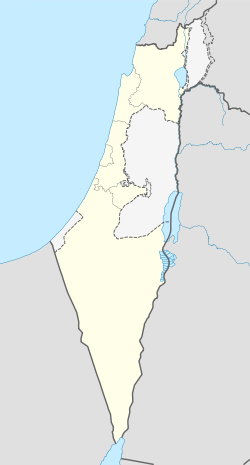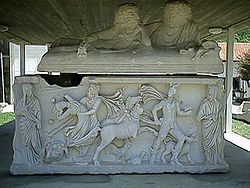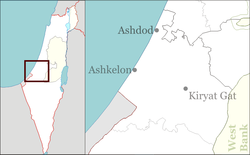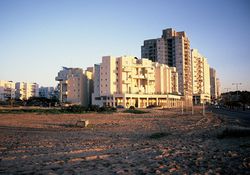Ashkelon
| Ashkelon | ||
 |
||
|
||
 Ashkelon
|
||
| District | South | |
| Government | City | |
| Hebrew | אַשְׁקְלוֹן | |
| (Translit.) | Ašqəlon | |
| Also spelled | Ashqelon (officially) | |
| Population | 111,700 (2009) | |
| Area | 47,788 dunams (47.788 km2; 18.451 sq mi) | |
| Mayor | Benny Vaknin | |
| Coordinates | ||
| Website | www.ashkelon.muni.il | |
Ashkelon or Ashqelon Arabic عسقلان ˁAsqalān (Hebrew: אַשְׁקְלוֹן (audio); Latin: Ascalon; Akkadian: Isqalluna) is a coastal city in the South District of Israel on the Mediterranean coast, 50 kilometres (31 mi) south of Tel Aviv. The ancient seaport of Ashkelon dates back to the Neolithic Age. In the course of its history, it has been ruled by the Canaanites, the Philistines, the Israelites, the Assyrians, the Babylonians, the Greeks, the Phoenicians, the Romans, the Persians, the Egyptians, the Crusaders, the Ottomans and the British. It was destroyed by the Mamluks in 1270 and fell into disuse.
The modern city of Ashkelon grew out of the Arab town of al-Majdal (Arabic: المجدل or Arabic: مجدل عسقلان, Hebrew: אל-מג'דל, מגדל). In 1596 it was a village of 559 Muslim households,[1][2] and in 1931, 6,166 Muslims and 41 Christians were living there.[3]
By 1948, the population had grown to about 11,000. During the 1948 Arab-Israeli War the city was for a time the forward position of the Egyptian Expeditionary Force in Gaza.[4] Most of the population fled to Gaza along with the retreating Egyptian Army. The city was captured by Israeli forces on November 5, 1948.
Over the years, Ashkelon grew to a population of 111,700.[5] The proximity to the beach and peaceful locale, made it an attractive destination for young families, as well as for retiring couples.
The beautiful beaches in Ashkelon still draw tourists from Israel and beyond.
The name of the shallot and the scallion derives from the name of this ancient city.
Contents |
History
Prehistory
Antiquity
ny.gif)


Ashkelon was the oldest and largest seaport in Canaan, one of the "five cities" of the Philistines, north of Gaza and south of Jaffa (Yafa). Archaeological excavations begun in 1985 led by Lawrence Stager of Harvard University are revealing the site with about 50 feet (15 m) of accumulated rubble from successive Canaanite, Philistine, Phoenician, Iranian, Hellenistic, Roman, Byzantine, Islamic, and Crusader occupation.

In the oldest layers are shaft graves of pre-Phoenician Canaanites. The city was originally built on a sandstone outcropping and has a good underground water supply. It was relatively large as an ancient city with as many as 15,000 people living inside walls a mile and a half (2.4 km) long, 50 feet (15 m) high and 150 feet (50 m) thick. Ashkelon was a thriving Middle Bronze Age (2000–1550 BCE) city of more than 150 acres (61 ha), with commanding ramparts including the oldest arched city gate in the world, eight feet wide, and even as a ruin still standing two stories high. The thickness of the walls was so great that the mudbrick Bronze Age gate had a stone-lined tunnel-like barrel vault, coated with white plaster, to support the superstructure: it is the oldest such vault ever found.
The Bronze Age ramparts were so capacious that later Roman and Islamic fortifications, faced with stone, followed the same footprint, a vast semicircle protecting Ashkelon on the landward side. On the sea it was defended by a high natural bluff.
Within the huge ramparts, in the ruins of a sanctuary, a votive silver calf was found in 1991. During the Canaanite period, a roadway more than 20 feet (6.1 m) in width ascended the rampart from the harbor and entered a gate at the top. Nearby, in the ruins of a small ceramic tabernacle was found a finely cast bronze statuette of a bull calf, originally silvered, 4 inches (100 mm) long. Images of calves and bulls were associated with the worship of the Canaanite gods El and Baal.
The Amarna letters correspondence of Ashkelon/(Ašqaluna), of 1350 BC, contains seven letters to the Egyptian pharaoh, from its 'King'/mayor: Yidya. Yidya was the only ruler of Ašqaluna during the 15–20-year time period. One letter from the pharaoh to Yidya was discovered in the early 1900s.
The Philistines conquered Canaanite Ashkelon about 1150 BCE. Their earliest pottery, types of structures and inscriptions are similar to the early Greek urbanised centre at Mycenae in mainland Greece, adding weight to the hypothesis that the Philistines were possibly one of the populations among the "Sea Peoples" that upset cultures throughout the eastern Mediterranean at that time. Ashkelon became one of the five Philistine cities that were constantly warring with the Israelites and the kingdom of Judah. According to Herodotus, its temple of Venus was the oldest of its kind, imitated even in Cyprus, and he mentions that this temple was pillaged by marauding "Scythians" during the time of their sway over the Medes (653–625 BCE). When this vast seaport, the last of the Philistine cities to hold out against Nebuchadnezzar finally fell in 604 BCE, burnt and destroyed and its people taken into exile, the Philistine era was over.
Ashkelon was soon rebuilt. It was an important Hellenistic seaport. In the period of the Hasmonean Kingdom, Rabbi Simeon ben Shetach – Pharisee scholar and Nasi of the Sanhedrin in the First Century BCE – is reported to have on a single day sentenced to death eighty Ashkelon women who had been charged with witchcraft. Later, the women's relatives took revenge by bringing false witnesses against Simeon's son and causing him to be executed in turn.[6]
The famous Queen Cleopatra VII used Ashkelon as her place of refuge when her brother and sister exiled her in 49 BCE. She built an army on the site but did not need to use it due to Julius Caesar's arrival in Alexandria.
Ashkelon may have been the birthplace of Herod the Great. Josephus makes it clear that Ashkelon was not ceded to Herod the Great in 30 BCE (War 1.396; Ant. 15.217), yet he built monumental buildings there: bath houses, elaborate fountains and large colonnades.[7]
The city remained loyal to Rome during the First Revolt, AD 66–70, and in the following centuries it grew to be an important centre. It appears on a fragment of the 6th century AD Madaba Map.
During the period of the Crusades, Ashkelon (which was known to the Crusaders as Ascalon) was an important city due to its location near the coast and between the Crusader States and Egypt. In 1099, shortly after the Siege of Jerusalem (1099), an Egyptian Fatimid army which had been sent to relieve Jerusalem was defeated by a Crusader force at the Battle of Ascalon. The city itself was not captured by the Crusaders because of internal disputes amongst their leaders. This battle is widely considered to have signified the end of the First Crusade. Until 1153, the Fatimids were able to launch raids into the Kingdom of Jerusalem from Ashkelon which meant that the southern border of the Crusader States was constantly unstable. In response to these incursions into Outremer, King Fulk of Jerusalem constructed a number of Christian settlements around the city during the 1130s, in order to neutralise the threat of the Muslim garrison. In 1148, during the Second Crusade, the city was unsuccessfully besieged for eight days by a small Crusader army which was not fully supported by the Crusader States. In 1150, the Fatimids fortified the city with fifty-three towers, as it was their most important frontier fortress. Three years later, after a five-month siege, the city was captured by a Crusader army led by King Baldwin III of Jerusalem. It was then added to the County of Jaffa to form the County of Jaffa and Ascalon which became one of the four major seigneuries of the Kingdom of Jerusalem.
After the Crusader conquest of Jerusalem the six elders of the Karaite Jewish community in Ashkelon contributed to the ransoming of captured Jews and holy relics from Jerusalem's new rulers. The Letter of the Karaite elders of Ascalon, which was sent to the Jewish elders of Alexandria, describes their participation in the ransom effort and the ordeals suffered by many of the freed captives.
Around 1163 Rabbi Benjamin of Tudela visited Ashkelon and found 'about two hundred rabbanite Jews' living there.[8]
In 1187 Saladin took Ashkelon as part of his conquest of the Crusader States following the Battle of Hattin. In 1191, during the Third Crusade, Saladin demolished the city because of its potential strategic importance to the Christians, but the leader of the Crusade, King Richard I of England, constructed a citadel upon the ruins. Ashkelon subsequently remained part of the diminished territories of Outremer throughout most of the 13th century and Richard, Earl of Cornwall reconstructed and refortified the citadel during 1240–41, as part of the Crusader policy of improving the defences of coastal sites. The Egyptians regained Ashkelon in 1247 during As-Salih Ayyub's conflict with the Crusader States and the city was returned to Muslim rule. The Mamluk dynasty came into power in Egypt in 1250 and the ancient and medieval history of Ashkelon was brought to an end in 1270, when the Mamluk sultan Baybars ordered the citadel and harbour at the site to be destroyed. As a result of this destruction, the site was abandoned by its inhabitants and fell into disuse.
According to Shiite tradition, the head of Husayn ibn Ali, grandson of Mohammad, was buried in Ashkelon. In the late 11th century it was moved to a new shrine named Mashad Nabi Hussein (or Sabni Hussein) built for the purpose. In 1153, at the time of the Crusaders' conquest of Ashkelon, the head was moved to Fustat (Egypt). The shrine remained and was described as the most magnificent building in Ashkelon.[9] In July 1950, it was totally destroyed at the instructions of Moshe Dayan.[10]
History of the modern city


The modern city of Ashkelon grew out of the Arab town of al-Majdal (Arabic: المجدل, Hebrew: אל-מג'דל, מגדל). In 1596, Majdal was a large village of 559 Muslim households, making it the 7th most populous locality in Palestine after Safad, Quds, Gaza, Nablus, Khalil and Kafr Kanna.[1][2] The census of 1931 found 6166 Muslims and 41 Christians living there.[3] By 1948, the population had grown to about 11,000.
Majdal was especially known for its weaving industry. The town had around 500 looms in 1909. But the industry suffered from cheap imports from Europe and by 1927 there were 119 'weaving establishments'. The three major fabrics that Al-Majdal produced were 'malak' (silk), 'ikhdari' (bands of red and green) and 'jiljileh' (dark red bands). These were used for festival dresses throughout Southern Palestine. Many other fabrics were produced, some with poetic names such as 'ji'nneh u nar' - 'heaven and hell', 'nasheq rohoh' - 'breath of the soul' and 'abu mitayn' - 'father of two hundred.'[11] After 1948 some of the weavers continue their trade in the refugee camps of the Gaza Strip.
1948 Arab-Israeli War
Soon after the declaration of the state of Israel, the Egyptian army occupied a large part of Gaza including Majdal. During the next few months, the town was subject to repeat Israeli attacks including air-raids and shelling.[12] All but about 1000 of the town's residents had fled by the time it was captured by Israeli forces as a sequel to Operation Yoav.
Arab-Israeli conflict
On 1–2 March 2008, rockets fired by Hamas from the Gaza Strip (some of them Grad rockets) hit Ashkelon, wounding seven, and causing property damage, marking the first time that Hamas had been able to reliably strike Ashkelon. The mayor, Roni Mahatzri has stated that, "This is a state of war, I know no other definition for it. If it lasts a week or two, we can handle that, but we have no intention of allowing this to become part of our daily routine."[13] On May 12, 2008, a rocket fired from the northern Gazan city of Beit Lahiya hit a shopping mall in southern Ashkelon, causing significant structural damage. According to The Jerusalem Post, "4 people were seriously injured, including a 24-year old woman and her young daughter. In addition, 87 people were treated for shock." 15 people suffered minor to moderate injuries as a result of the collapsed structure. Southern District Police chief Commander Uri Bar-Lev believed the Grad-model Katyusha rocket that hit Ashkelon was manufactured in Iran.[14]
Economy
Ashkelon is the northern terminus for the Trans-Israel pipeline, which brings petroleum products from Eilat to an oil terminal at the port. In 2005 the world's then largest water desalination plant opened at Ashkelon with a capacity of 330,000 cubic meters of water produced per day. The project was undertaken by VID, which is a consortium between Veolia Environnement and IDE Technologies. The project at the time represented not only the largest desalination plant in the world but also the lowest cost desalination plant ($0.52 per cubic meter).
Israel Beer Breweries is located in the city since 1992 and brews under licence the Danish Carlsberg and Tuborg beer brands for the Israeli market. The brewery is owned by the Central Bottling Company, which also holds the Israeli franchise for Coca-Cola products since 1968.[15]
Education

The city has 19 elementary schools, and nine junior high and high schools. The Ashkelon Academic College opened in 1998, and now hosts thousands of students.
Twin towns
Ashkelon is twinned with:
 Côte Saint-Luc, Quebec, Canada
Côte Saint-Luc, Quebec, Canada Xinyang, China
Xinyang, China Iquique, Chile
Iquique, Chile Aix-en-Provence, France[16][17]
Aix-en-Provence, France[16][17] Kutaisi, Georgia
Kutaisi, Georgia Berlin-Weißensee, Germany
Berlin-Weißensee, Germany Sopot, Poland
Sopot, Poland Entebbe, Uganda
Entebbe, Uganda Portland, Oregon, United States
Portland, Oregon, United States Baltimore, Maryland, United States[18]
Baltimore, Maryland, United States[18]
References
- ↑ 1.0 1.1 Hütteroth, Wolf-Dieter and Kamal Abdulfattah (1977), Historical Geography of Palestine, Transjordan and Southern Syria in the Late 16th Century. Erlanger Geographische Arbeiten, Sonderband 5. Erlangen, Germany: Vorstand der Fränkischen Geographischen Gesellschaft.
- ↑ 2.0 2.1 Petersen, Andrew (2005). The Towns of Palestine under Muslim Rule AD 600-1600. BAR International Series 1381. p. 133.
- ↑ 3.0 3.1 Palestine Office of Statistics, Vital Statistical Tables 1922-1945, Table A8.
- ↑ "Archaeological Sites in Israel - Ashkelon". ERETZ Magazine. http://www.eretz.com/NEW/archaeology.shtml. Retrieved 2008-10-22.
- ↑ "Table 3 - Population of Localities Numbering Above 1,000 Residents and Other Rural Population". Israel Central Bureau of Statistics. 2008-06-30. http://www.cbs.gov.il/population/new_2009/table3.pdf. Retrieved 2008-10-18.
- ↑ "Tractate Sanhedrin". http://www.jewishvirtuallibrary.org/jsource/Talmud/sanhedrin6.html#fn_40. Retrieved 2009-04-15.
- ↑ "Ashkelon". Project on Ancient Cultural Engagement (PACE). http://pace.mcmaster.ca/York/york/placePopup?id=24&descOnly=true. Retrieved 2008-10-22.
- ↑ ^ 'Early Travels in Palestine, comprising the narratives of Arculf, Willibald, Bernard, Saewulf, Sigurd, Benjamin of Tudela, Sir John Maundeville, De la Brocquiere, and Maundrell. Editor Dr. Thomas Wright. 1848. pub. Bohn, London. page 87. 'This city is very large and handsome'.
- ↑ Moshe Gil, A History of Palestine, 634-1099 (1997) p 193–194.
- ↑ Meron Rapoport, History Erased, Haaretz, July 5, 2007. [1]
- ↑ Shelagh Weir, 'Palestinian Costume'. British Museum Publications, 1989. ISBN 978-0-7141-1597-9. pages 27-32. Other fabrics produced: 'Shash' - white muslin for veils. Burk/Bayt al-shem - plain cotton for underdresses. 'Karnaish' - white cotton with stripes. 'Bazayl' - flannelette. 'Durzi' - blue cotton. 'Dendeki' - red cotton.
- ↑ B. Morris, The transfer of Al Majdal's remaining Arabs to Gaza, 1950, in 1948 and After; Israel and the Palestinians.
- ↑ "Israeli City Shocked As Rockets Hit". Associated Press. 2008-03-03.
- ↑ "Iranian made rocket strikes Ashkelon - Ashkelon". Jeruselum Post. http://www.jpost.com/servlet/Satellite?cid=1210668639052&pagename=JPost%2FJPArticle%2FShowFull. Retrieved 2008-05-15.
- ↑ "The Central Bottling Company Group - Company Profile". Dun & Bradstreet Israel - Dun's 100 Israel's Largest Enterprises 2009. http://www.duns100.com/ts.cgi?tsscript=comp_eng&duns=600057582. Retrieved 2009-11-22
- ↑ Association of twinnings and international relations of Aix-en-Provence
- ↑ Mairie of Aix-en-Provence - Twinnings and partnerships
- ↑ "Baltimore City Mayor's Office of International and Immigrant Affairs - Sister Cities Program". http://www.baltimorecity.gov/government/intl/sistercities.php. Retrieved 2009-07-18.
- Golan, Arnon (2003). "Jewish Settlement of Former Arab Towns and their Incorporation into the Israeli Urban System (1948–1950)". Israel Affairs 9: 149–164. doi:10.1080/714003467.
- Kafkafi, Eyal (1998). "Segregation or Integration of the Israeli Arabs: Two Concepts in Mapai". International Journal of Middle East Studies 30 (3): 347–367. doi:10.1017/S0020743800066216. http://journals.cambridge.org/action/displayAbstract?fromPage=online&aid=5195700&fulltextType=RA&fileId=S0020743800066216.
- Townsend, Christopher (2006). God's War: A New History of the Crusades. Penguin Books ltd. ISBN 978-0-7139-9220-5.
External links
- Ashkelon City Council
- Ashkelon Online News Magazine (Hebrew)
- "Ashkelon, ancient city of the sea", National Geographic, January 2001
- Ancient Ashkelon—University of Chicago
- Pictures of Ashkelon—Holy Land Pictures
|
||||||||||||||||||||
|
||||||||||||||
